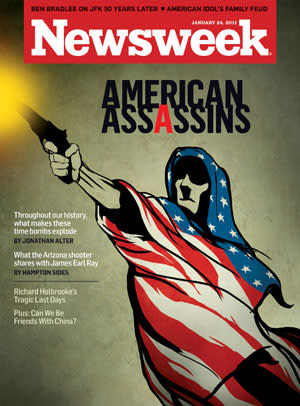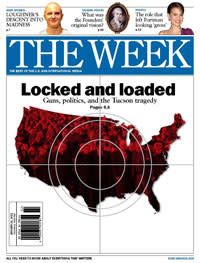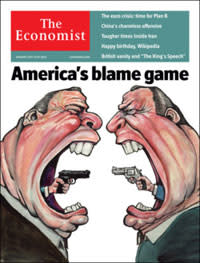 The Cutline
The CutlineCaught in the cross hairs, magazines put Tucson on the cover

The shadowy character pictured on the cover of Newsweek's Jan. 24 issue, out Monday, looks like a comic book villain. Shrouded in an outsize American flag that smothers his body like a Snuggie, the menacing figure aims a pistol skyward, squeezing the trigger with his right hand. The accompanying headline, "American Assassins," touts the latest entry in a long series of pieces seeking to explain the Jan. 8 shooting spree outside a Tucson, Ariz. supermarket that claimed six lives and left Congresswoman Gabrielle Giffords critically injured.
[Related: Giffords' husband discusses recovery in first interview]
"We thought that the deeper sickness in this population of assassins and what it says about some of the darker strings in the American story was worth touching on," said Jonathan Alter, author of the piece. In his cover story, Alter contrasts the history of assassins abroad (religious and political extremists; organized criminals) with the history of those in America (emotionally tormented and socially isolated loners who suffer from mental illness; e.g. Jared Loughner). "When you're a weekly, the basic problem is that everything's been said, just not everybody's said it, so we're always in the market for a fresh angle and perspective."
Indeed, daily papers, blogs, news websites and cable networks were on the front lines of this tragic story, which has captured the American media's attention for the past nine days. Reporters descended on Tucson, churned out scoop after scoop to advance the overall narrative, even if only incrementally, and tracked down Loughner's neighbors, friends, professors and former classmates. At the same time, the weeklies were busy preparing their long-view takes and presenting compelling images to package their more conceptual treatments of the subject. It's a delicate balance -- go too far and risk being accused of yellow journalism; play it too safe and risk being lost in the crowd.
"These types of stories present a big challenge to any editor," said William Falk, editor-in-chief of The Week. "It's a question of being appropriate within the context of something that's very horrible. You want to get something that has the right tone."
Take Loughner's ubiquitous mugshot. The disturbing image, which shows the 22-year-old accused gunman bald and black-eyed with a crooked, remorseless smirk, proved to be nearly a textbook example of a powerful front-page newspaper photo. Whether it makes for a good magazine cover is another matter.
Newsweek, for one, didn't consider using it. "I think everybody had seen that image," said Alter. But that didn't deter Newsweek's rival, Time, whose first post-Tucson issue came out several days earlier.
"Time's take turns Loughner into something of a movie villain, making the photo grainy in black and white, plus decorating his forehead with a graphic," wrote Joe Coscarelli of The Village Voice. "It's arresting, to be sure, but it's also sensational." (Of the various publications The Cutline approached for this story, Time was the only one that declined to comment.)
The Week, a digest of news and commentary whose latest issue came out Friday, also decided to forgo a cover image of Loughner's haunting gaze. "It's an incredibly newsworthy picture, but there's so much madness and glee coming out of his face that it's hard to look at it blown up in a big way," said Falk. Falk also said he didn't think the image was appropriate to go with the standard caricature illustration that almost always graces his magazine's covers. "It's too somber a story," he said.
Instead, Falk opted to reference Sarah Palin's controversial U.S. "target" map, on which red and white apparent gun sites (characterized by one Palin spokeswoman as "surveyor's marks") take aim at 20 key Democratic districts. The Week's end product is a red-tinted photo -- framed in an outline of the United States -- of Congress members bowing their heads during a moment of silence. The image is seen as if through a rifle's crosshairs. "We tried to put our emphasis on the debate," said Falk of The Week's coverage, and "the crosshairs were such a huge part of that debate."
Other publications adopted the same visual approach. "These crosshairs became almost immediately a potent symbol for what happened and this debate over how far is too far when it comes to political language," said Taylor West, a spokeswoman for National Journal, whose current cover simply consists of red crosshairs over a black background. "This was a dramatic way to get at the urgency of the conversations inside the magazine." They also made a cameo in The Stranger, a Seattle alt-weekly whose cover last week satirized Palin's map. In The Stranger's version, the locations of political assassinations and assassination attempts stand in for the Democrats who Palin's political action committee was aiming to unseat last year. "Sarah Palin did not put a gun into Jared Lee Loughner's hands ... but Sarah Palin and her cronies have spent the past two years cranking crazies like Loughner up," wrote Paul Constant in his accompanying piece. (To be fair, many agree that Loughner's massacre shouldn't be chalked up to anything more than a dangerously unstable mind.)
[Photos: Unsettling mugshot of Jared Loughner]
New York Press used the crosshairs -- blown up over the headline, "Will the Real Sarah Palin Please Stand Up?" -- to illustrate a cover story that took Palin to task for her "muted" response to the tragedy. "Being a small weekly publication in New York City, we have to shout to be heard above the rest, so when we are designing our covers we often try to make a big statement that can be seen on the street," said editor-in-chief Jerry Portwood. (Tucson's local alt-weeklies, for their part, both went with stock photos of their wounded congresswoman.)
Meanwhile, over at The Economist, it became clear last Monday "that our intention was to put this [story] on the cover," said Edward McBride, the magazine's Washington correspondent, who penned one of two lead features from this week's issue. "America's blame game," reads the cover line. Below it is a cartoonish illustration of two fat politicians engaged in an angry face off, handguns protruding from their over sized mouths.
The concept, McBride explained, was two-pronged.
"On the one hand, we wanted to try to explain to people outside America some things they might find surprising," he said. "I thought the lack of enthusiasm for stricter gun control measures is something that would be striking to outsiders."
[Related: Giffords' husband willing to meet Jared Loughner's parents]
On the other hand, he noted, "We were trying to give our audience a sense of the political response, and the debate about what roll vitriolic political discourse played. We tried to make clear that we didn't accept the argument that somehow, overheated political rhetoric had contributed to the massacre. We don't see the role played by political discourse. We do see the role played by guns."
Other popular stories on Yahoo!:
• Palin explains comment on Ariz. shooting
• With shock subsiding, pain sets in for Ariz. victims
• Photos: Coping with the Arizona shooting tragedy
Giffords'





